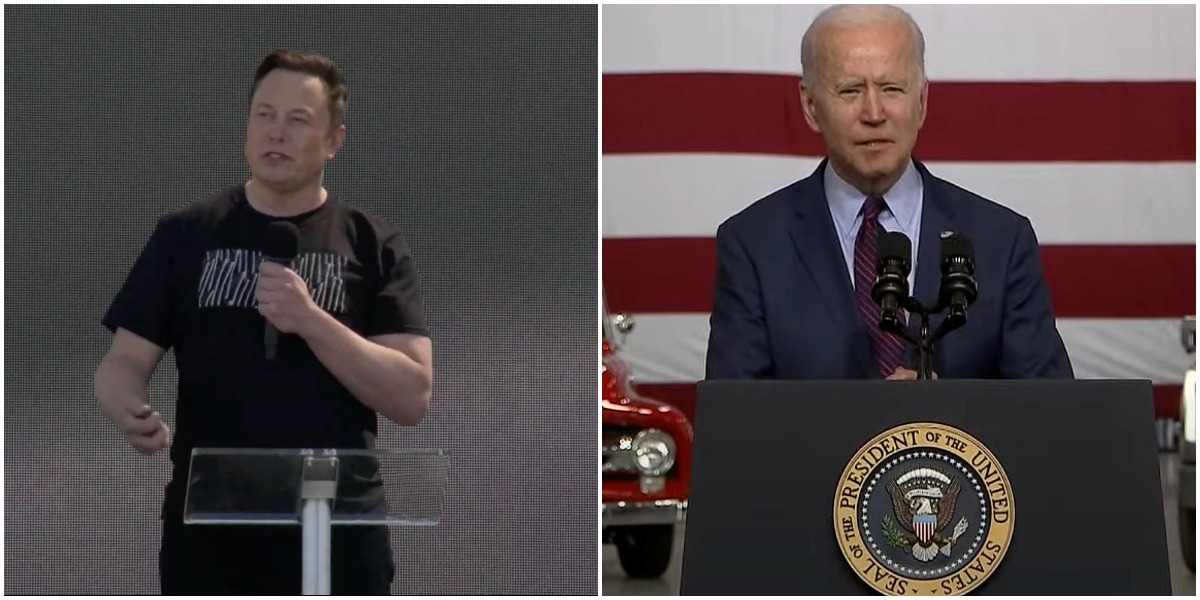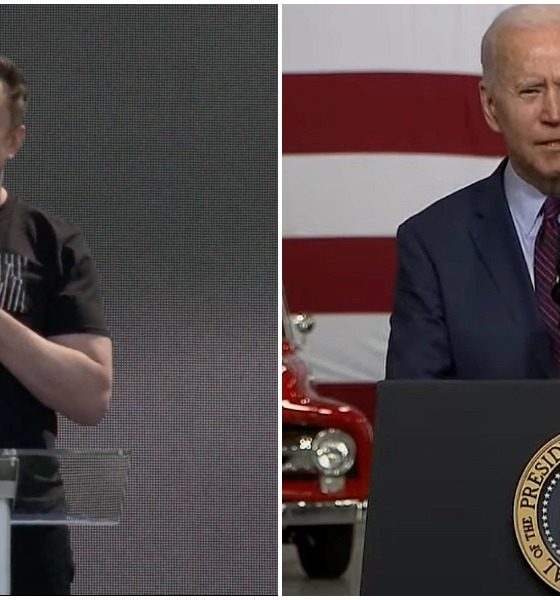

News
A closer look at Joe Biden and Elon Musk’s feud, and the US President’s potential miscalculation
For all intents and purposes, US President Joe Biden and Tesla CEO Elon Musk should agree on a number of things. Both men have worked hard to fight climate change, and both openly support electric vehicles. Yet for the longest time now, a feud seems to have developed between Biden and Musk.
It’s not a stretch to state that a lot of the feud is due to Biden — and it will likely be a gross miscalculation on the President’s part.
It’s easy to shoehorn Elon Musk as a villain. The man’s a billionaire; he’s stated that he is voting against Democrats in the coming elections; he has even traded sarcastic barbs with popular left-leaning politicians over the past months. But what is easily forgotten these days is that Musk has, for the longest time, been a supporter of Democrats, including Biden himself.
Musk said as much recently on Twitter when he noted that he voted for both Hillary Clinton and Joe Biden in the last two presidential elections. Musk was also quite close to the Obama administration. So what really encouraged Musk to switch to the right, even if Biden’s administration has characterized itself as one that is focused on climate issues and sustainability?
Some would note that the Musk and Biden feud started with the US President’s overt support for unions, but things actually started before that. As early as February 2021, Elon Musk hinted at some of his disagreements with the Biden administration. Musk was lobbying for a carbon tax then, but the CEO noted that the Biden team believed that such an initiative “seems too politically difficult.”
Musk has noted recently that his shift to the right is in no small part due to Biden’s administration doing “everything it can to sideline and ignore Tesla.” Musk critics would easily disregard these statements as entitled whining from the CEO (cue the aged Elon Musk Simpson’s “weird nerds” meme), but he does have a point. Since rejecting Musk’s suggestion for a carbon tax, the Biden administration has barely acknowledged Tesla, focusing instead on more traditional automakers that are, for the most part, doing far less for sustainability than Tesla.
This happened recently following what appeared to be Biden’s latest zinger against Musk, where he wished the CEO “lots of luck on his trip to the Moon” when asked about Musk’s concerns about the US economy. Biden proceeded to promote Ford’s efforts to hire 6,000 workers while conveniently denying that Tesla had nearly hired 50,000 people worldwide in the last two years.
Overall, the Biden and Musk feud is downright strange. From an outsider’s perspective, it really doesn’t make sense. Every person who has followed Tesla and SpaceX over the years would know that Musk’s companies are practically a perfect match for politicians on the left. Yet Biden, for some strange reason, opted to antagonize Musk instead. Biden’s not alone either, as other high-profile Democrats have also joined in on the anti-Musk bandwagon — to varying degrees of aggressiveness.
Such a strategy, however, may cost Biden in the upcoming elections. Musk is a prolific CEO, after all, and his social media presence — even if it is likely padded by bots considering Twitter’s issues with fake and spam accounts — is notable. By constantly beating on Musk while ignoring Tesla and SpaceX, Biden and his administration may end up alienating a significant part of the left’s voter base. The upcoming elections would likely show if this would be the case or not.
Don’t hesitate to contact us with news tips. Just send a message to simon@teslarati.com to give us a heads up.

Elon Musk
Elon Musk and Tesla AI Director share insights after empty driver seat Robotaxi rides
The executives’ unoccupied tests hint at the rapid progress of Tesla’s unsupervised Robotaxi efforts.

Tesla CEO Elon Musk and AI Director Ashok Elluswamy celebrated Christmas Eve by sharing personal experiences with Robotaxi vehicles that had no safety monitor or occupant in the driver’s seat. Musk described the system’s “perfect driving” around Austin, while Elluswamy posted video from the back seat, calling it “an amazing experience.”
The executives’ unoccupied tests hint at the rapid progress of Tesla’s unsupervised Robotaxi efforts.
Elon and Ashok’s firsthand Robotaxi insights
Prior to Musk and the Tesla AI Director’s posts, sightings of unmanned Teslas navigating public roads were widely shared on social media. One such vehicle was spotted in Austin, Texas, which Elon Musk acknowleged by stating that “Testing is underway with no occupants in the car.”
Based on his Christmas Eve post, Musk seemed to have tested an unmanned Tesla himself. “A Tesla with no safety monitor in the car and me sitting in the passenger seat took me all around Austin on Sunday with perfect driving,” Musk wrote in his post.
Elluswamy responded with a 2-minute video showing himself in the rear of an unmanned Tesla. The video featured the vehicle’s empty front seats, as well as its smooth handling through real-world traffic. He captioned his video with the words, “It’s an amazing experience!”
Towards Unsupervised operations
During an xAI Hackathon earlier this month, Elon Musk mentioned that Tesla owed be removing Safety Monitors from its Robotaxis in Austin in just three weeks. “Unsupervised is pretty much solved at this point. So there will be Tesla Robotaxis operating in Austin with no one in them. Not even anyone in the passenger seat in about three weeks,” he said. Musk echoed similar estimates at the 2025 Annual Shareholder Meeting and the Q3 2025 earnings call.
Considering the insights that were posted Musk and Elluswamy, it does appear that Tesla is working hard towards operating its Robotaxis with no safety monitors. This is quite impressive considering that the service was launched just earlier this year.
Elon Musk
Starlink passes 9 million active customers just weeks after hitting 8 million
The milestone highlights the accelerating growth of Starlink, which has now been adding over 20,000 new users per day.

SpaceX’s Starlink satellite internet service has continued its rapid global expansion, surpassing 9 million active customers just weeks after crossing the 8 million mark.
The milestone highlights the accelerating growth of Starlink, which has now been adding over 20,000 new users per day.
9 million customers
In a post on X, SpaceX stated that Starlink now serves over 9 million active users across 155 countries, territories, and markets. The company reached 8 million customers in early November, meaning it added roughly 1 million subscribers in under seven weeks, or about 21,275 new users on average per day.
“Starlink is connecting more than 9M active customers with high-speed internet across 155 countries, territories, and many other markets,” Starlink wrote in a post on its official X account. SpaceX President Gwynne Shotwell also celebrated the milestone on X. “A huge thank you to all of our customers and congrats to the Starlink team for such an incredible product,” she wrote.
That growth rate reflects both rising demand for broadband in underserved regions and Starlink’s expanding satellite constellation, which now includes more than 9,000 low-Earth-orbit satellites designed to deliver high-speed, low-latency internet worldwide.
Starlink’s momentum
Starlink’s momentum has been building up. SpaceX reported 4.6 million Starlink customers in December 2024, followed by 7 million by August 2025, and 8 million customers in November. Independent data also suggests Starlink usage is rising sharply, with Cloudflare reporting that global web traffic from Starlink users more than doubled in 2025, as noted in an Insider report.
Starlink’s momentum is increasingly tied to SpaceX’s broader financial outlook. Elon Musk has said the satellite network is “by far” the company’s largest revenue driver, and reports suggest SpaceX may be positioning itself for an initial public offering as soon as next year, with valuations estimated as high as $1.5 trillion. Musk has also suggested in the past that Starlink could have its own IPO in the future.
News
NVIDIA Director of Robotics: Tesla FSD v14 is the first AI to pass the “Physical Turing Test”
After testing FSD v14, Fan stated that his experience with FSD felt magical at first, but it soon started to feel like a routine.

NVIDIA Director of Robotics Jim Fan has praised Tesla’s Full Self-Driving (Supervised) v14 as the first AI to pass what he described as a “Physical Turing Test.”
After testing FSD v14, Fan stated that his experience with FSD felt magical at first, but it soon started to feel like a routine. And just like smartphones today, removing it now would “actively hurt.”
Jim Fan’s hands-on FSD v14 impressions
Fan, a leading researcher in embodied AI who is currently solving Physical AI at NVIDIA and spearheading the company’s Project GR00T initiative, noted that he actually was late to the Tesla game. He was, however, one of the first to try out FSD v14.
“I was very late to own a Tesla but among the earliest to try out FSD v14. It’s perhaps the first time I experience an AI that passes the Physical Turing Test: after a long day at work, you press a button, lay back, and couldn’t tell if a neural net or a human drove you home,” Fan wrote in a post on X.
Fan added: “Despite knowing exactly how robot learning works, I still find it magical watching the steering wheel turn by itself. First it feels surreal, next it becomes routine. Then, like the smartphone, taking it away actively hurts. This is how humanity gets rewired and glued to god-like technologies.”
The Physical Turing Test
The original Turing Test was conceived by Alan Turing in 1950, and it was aimed at determining if a machine could exhibit behavior that is equivalent to or indistinguishable from a human. By focusing on text-based conversations, the original Turing Test set a high bar for natural language processing and machine learning.
This test has been passed by today’s large language models. However, the capability to converse in a humanlike manner is a completely different challenge from performing real-world problem-solving or physical interactions. Thus, Fan introduced the Physical Turing Test, which challenges AI systems to demonstrate intelligence through physical actions.
Based on Fan’s comments, Tesla has demonstrated these intelligent physical actions with FSD v14. Elon Musk agreed with the NVIDIA executive, stating in a post on X that with FSD v14, “you can sense the sentience maturing.” Musk also praised Tesla AI, calling it the best “real-world AI” today.








